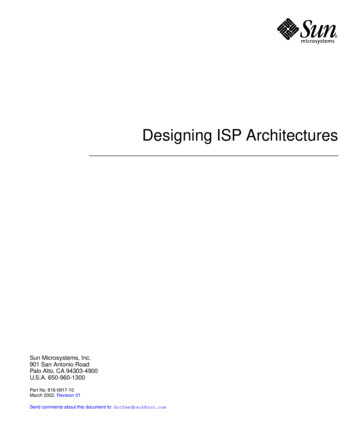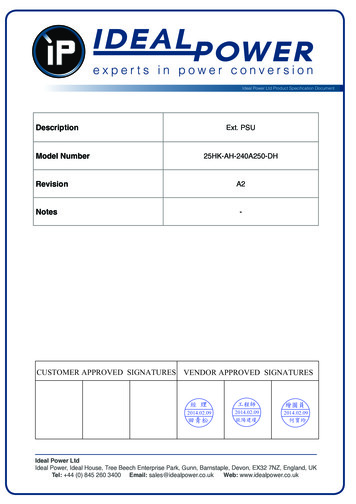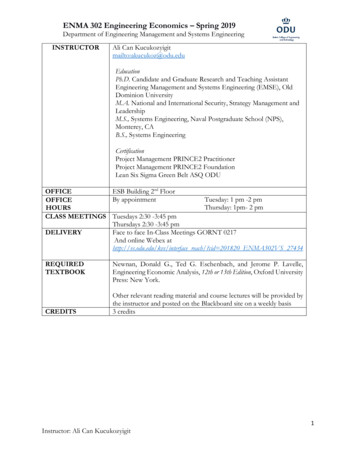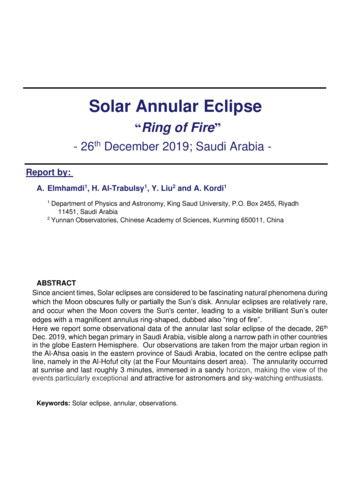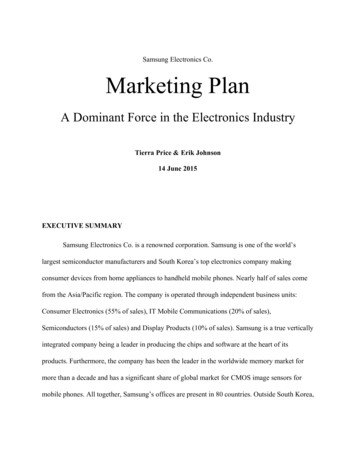
Transcription
Samsung Electronics Co.Marketing PlanA Dominant Force in the Electronics IndustryTierra Price & Erik Johnson14 June 2015EXECUTIVE SUMMARYSamsung Electronics Co. is a renowned corporation. Samsung is one of the world’slargest semiconductor manufacturers and South Korea’s top electronics company makingconsumer devices from home appliances to handheld mobile phones. Nearly half of sales comefrom the Asia/Pacific region. The company is operated through independent business units:Consumer Electronics (55% of sales), IT Mobile Communications (20% of sales),Semiconductors (15% of sales) and Display Products (10% of sales). Samsung is a true verticallyintegrated company being a leader in producing the chips and software at the heart of itsproducts. Furthermore, the company has been the leader in the worldwide memory market formore than a decade and has a significant share of global market for CMOS image sensors formobile phones. All together, Samsung’s offices are present in 80 countries. Outside South Korea,
Samsung has regional headquarters in the US, Europe, Asia, Brazil, Russia, South Africa, andthe UAE. 40 manufacturing plants are located in countries across the world. Of markets,America is its single largest market that accounts for 30% of sales. The company enjoys steadygrowth in both its native and U.S. dollars. Primary growth strategies to solidify marketleadership consist of focus on product differentiation in each business unit, identifyingbusinesses of sustainable growth over long periods of time and management preparations toanticipate and respond to business risks with global market uncertainties. The company showsimportance in continuing growth in key products areas that consumers desire most, such asphones, tablets, LCD panels, flat panel TVs, system LSI chips, IT products and home appliances.Additionally, Samsung is promoting future growth around software and service opportunitiescontinuing to lay a foundation for future business opportunities with endeavors in other fieldslike health and medical equipment markets. Samsung Electronics is investing in industries it isnot traditionally known for with a goal to grow as a healthcare technology player. In accordanceto sales and marketing, Samsung uses a direct sales approach that operates from offices locatedin more than 50 countries. Products for the consumer market are sold through major retailersworldwide and by e commerce. Other products, such as the LCD and OLED panels made bySamsung Display, are sold to OEMs. Chips made by Samsung Semiconductor are sold directlyas well as through distributors. Samsung is very well rounded when it comes to marketingmanagement and nothing less would be expected from a global corporation. The companymarkets its products through many different mediums including billboards, televisioncommercials, online advertisements and sweepstakes/awards allowing information about theirproducts to reach a variety of different subsets of the public. By doing this they are able to reach
a maximum capacity of potential consumers and largest possible amounts of profits. SamsungElectronics Co. is also a leader in customer satisfaction within their market. In a surveyconsisting of 70,000 U.S. based consumers on a range of products and services respondents gaveSamsung a respectable satisfaction rating of 81/100 points which increased five points from lastyear and most importantly, is two point ahead of their top competitor, Apple. Samsung shows agreat understanding of offering products to meet customer needs to accomplish company goals.They know what their consumers want, they communicate the benefits, deliver products in a waythat makes it available for a variety of consumers and create customer value. Samsung simplybrings more to the table than the average electric company and that is very attractive toconsumers. Since the company’s offers a endless selection of electronic products that havedemonstrated outstanding performance over the years and continue to improve, they show greatvalue in customer satisfaction. Furthermore, Endeavoring in other industries to meet the demandin healthcare technologies shows their agility in meeting the needs of consumers well beyondtheir specialty. In return, customers of Samsung have become very loyal, continue purchasing avariety of their products, and chose them over other competitors. The company's marketing mixis extremely diverse in all 4P’s of marketing which has resulted in a great level of competitiveadvantage. Samsung’s strategies for growth show great attention in The Marketing ConceptsGuides Ethics as they focus on future outcomes and strategies to handle any situation regardinggroup needs and individual needs. Samsung Electronics Co. because is very well rounded in itsefforts and strategies of marketing management.TABLE OF CONTENTS
1. CURRENT MARKETINGENVIRONMENT . 1.1 MARKETSEGMENTS .1.2 PRODUCTENVIRONMENT .1.3 COMPETITIVEENVIRONMENT 1.4 DISTRIBUTIONENVIRONMENT .1.5 MACRO ECONOMICENVIRONMENT .2. MARKETINGOBJECTIVES 3. MARKETINGSTRATEGIES .3.1 TARGETMARKET 3.2 PRODUCTSTRATEGIES 3.3 PROMOTIONSTRATEGIES 3.3.1 CUSTOMERSERVICE 3.3.2ADVERTISING 3.3.3. PERSONAL
SELLING 3.3.4. SALESPROMOTION 3.4. DISTRIBUTIONSTRATEGIES 3.5. PRICINGSTRATEGIES 4.CONTROLS APPENDIX 1 ANALYSIS OF CURRENT MARKETING SITUATION Market SegmentsSamsung Electronics markets in global segments based on lifestyle and demographicvariables. Of its top level segment are countries like North America, Central and South America,Europe, Middle East, Southeast Asia, Southwest Asia, China and Korea. The segments differbased on lifestyle and demographics, for example cultures, but Samsung is able to segment itsglobal segments into segments of urban and rural consumers. These segments will differ mostlikely in lifestyle even further, income, and needs and wants, yet they may desire technology andproducts that Samsung has to offer. For example, urban dwellers would most likely desiresomething high tech, while rural consumers may desire basic home appliances. Theres is also asecond level at which samsung segments its products. Within the market segments, people preferhigh quality products, athletics, technology and convenience. Business people, innovative/creative minds and high class middle aged consumers are most likely to purchase products ofSamsung Product EnvironmentSamsung offers a variety of products within the market. They range from homeappliances, to healthcare technologies. Some examples of what kind of products they sell arerefrigerators, televisions, x ray machines, memory disks, printers and mobile cell phones.
Collectively these products have accumulated total sales of 165,002 to 228,693 from 2011 to2013 and profits of 15,644 to 36,785 from 2011 to 2013 in billions KRW. Product featuresconsist of curved UHD TVs, world’s largest capacity refrigerator, multifunctional Androidtouchscreen all in one printer, wireless detector and image processing engine in x ray machines,and high quality touch display mobile devices, etc. Mobile phones generate 42% of profit, whiletelevision generates 30%. Specifically, we would like to focus on home appliances and cellulardevices. For example, cell phones, computers, televisions and refrigerators. Narrowing ourproduct environment to a smaller portion of products of Samsung will allow our company tofocus more directly on specific goods and achieve greater results from our marketing to thesespecific product. Competitive EnvironmentSome major companies that are in competition with Samsung Electronics Co. in theirmobile department are LG, Xiaomi, and Apple Inc.1. LG LG is an electronic company that is big on research and development; just likeSamsung. Some strengths LG has is its known globally, their products are reliable, it is aleader in innovation, and it is a rapidly growing company. Weaknesses LG has is it is notas big as some of its competitors and does not have the same financial strength. LGcurrently also has a small market share. The market segments LG seems to focus on isthe lower income and the younger generation.2. Xiaomi Xiaomi is a very new electronics company that is emerging into the marketrapidly. Some strengths Xiaomi has is its ability to make high end devices and sell themat cheaper prices and its rapidly increasing into the mobile market. Right now in Chinathey are the biggest cell phone distributor; crushing Samsung and Apple. WeaknessesXiaomi has is it is not in the U.S. yet and seems to copy off of a lot of the othercompanies. This could be hindering them from entering the U.S. market. Xiaomi’starget market is the lower income population. They are really big about offering highquality products for cheap prices.3. Apple Apple is an electronic/technology company that mostly focuses on products suchas laptops, cellular phones, and tablets. Some strengths Apple Inc has is its total controlof products, innovation, and financial strength. A weakness Apple Inc has its premiumpricing for products that may not be as powerful as some competitors. Another weaknessis they do not have a variety of products. Instead, they really only focus on a select fewproducts at a time. The market segments that Apple seems to targeting is the youngergeneration and business professionals. Distribution Environment
Products are normally distributed to customers by retailers but start at the manufacturer.Products go from the manufacturer, to the distributor/dealer, then the retailer, and finally thecustomer. The distribution environment that Samsung is associated with is mostly a mix of bothcorporate and contractual channel systems. Most companies in the mobile department aremanufacturing their own devices. Samsung deals with customers in direct sales and throughretailers or franchises. Most sales from the mobile industry come from dealers who first buytheir products and then resell them to the public. Examples of this are Verizon, At&t, and Sprint.The growth is selling to the dealers because it is cheaper for the companies to do so. It costs a lotto open and maintain a store so it makes more sense to have these dealers or franchisees sellproducts for them. These big manufacturing companies will spend less with the dealers becausethey are giving them incentives to do so. Macro Economic EnvironmentThere are several economic factors/trends that could impact the performance. One trendis the decrease of the middle class. With the middle class diminishing it will be hard to sellhigher or mid ranged products and will drive prices lower which will create even morecompetition. Another economic trend is the rise of emerging markets. Some countries aroundthe world are rapidly developing and could bring new ideas and competition to the market. Thisalso could cause a decrease in profits.Technological factors are the constant battle for the best and most innovative product onthe market. All the electronic companies are constantly putting tons of money into the researchand development areas of their company. The reason for this is because there is a lot of demandfor innovative electronic products around the world. If an electronic company falls behind in thetechnological aspect, then they will absolutely see a decline in sales.2. MARKETING OBJECTIVESSamsung Electronics is determined to stay ahead of the competition with innovation andexpertise of the electronic industry. Samsung would like to build its brand to show people thecontinued excellence of these products. The objectives we may want to consider are thefollowing: Generate new ideas to penetrate other markets or segments within the wirelessindustry. We want to achieve another 5% of the market share within the nextyear. Continue to grow and develop. We want to decrease the cost in production in thewireless industry so we can be more profitable. Although new technology costs
more money, there is always a way to be more profitable. We should be able tocut production cost by 20% in the next three years.Spread brand name by attending shows and sponsoring events. Marketing teamneeds to have an appearance at shows and events where there is a lot of peoplemore often. We want brand new customer numbers to rise by 5% within the nexttwo years.Implement surveys or other experiments to gain customer feedback and improvesatisfaction. Give surveys to be filled out with every customers purchase. Wewant at least a 95% satisfaction rate for the next 3 years.3. MARKETING STRATEGIES3.1 Target Market(s)The firm segments mainly on lifestyle and demographic variables, but we suggest layingmore emphasis on the changing lifestyles of the young generation and cater for their everchanging needs as they are becoming increasingly advanced in technology. The company cansegment the market into urban and then rural people to regain market share. The general targetedage is 15 30 in order to compete favorably with competitive brands in the same market segment.The targeted group of people focuses mainly on music, leisure and has a flair for new gadgets.We intend marketing to these targets because it is known that younger generations of people aremore advanced with technology, therefore a twenty year old is more likely to purchase and useour product that a sixty five year old person. By focusing on target markets where consumers aremost likely to purchase o
Market Segments Samsung Electronics markets in global segments based on lifestyle and demographic variables. Of its top level segment are countries like North File Size: 252KBPage Count: 14




